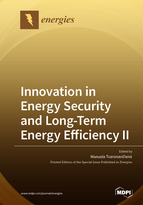Innovation in Energy Security and Long-Term Energy Efficiency Ⅱ
A special issue of Energies (ISSN 1996-1073). This special issue belongs to the section "C: Energy Economics and Policy".
Deadline for manuscript submissions: closed (31 May 2021) | Viewed by 28781
Special Issue Editor
Interests: economic growth; investments; innovations; sustainable development; sector development; energy security; energy effciency
Special Issues, Collections and Topics in MDPI journals
Special Issue Information
Dear colleagues,
The sustainable development of our planet depends on the use of energy. The increasing population of the world inevitably causes an increase in the demand for energy, which, on the one hand, threatens us with the potential to encounter a shortage of energy supply, and, on the other hand, causes the deterioration of the environment.
Therefore, our task is to reduce this demand through different innovative solutions (i.e., both technological and social). Social marketing and economic policies can also play their role by affecting the behavior of households and companies, by causing behavioral change oriented to energy stewardship, and an overall switch to renewable energy resources. This Special Issue provides a platform for the exchange of a wide range of ideas, which, ultimately, would facilitate in driving societies to long-term energy efficiency.
Prof. Dr. Manuela Tvaronavičienė
Guest Editor
Manuscript Submission Information
Manuscripts should be submitted online at www.mdpi.com by registering and logging in to this website. Once you are registered, click here to go to the submission form. Manuscripts can be submitted until the deadline. All submissions that pass pre-check are peer-reviewed. Accepted papers will be published continuously in the journal (as soon as accepted) and will be listed together on the special issue website. Research articles, review articles as well as short communications are invited. For planned papers, a title and short abstract (about 100 words) can be sent to the Editorial Office for announcement on this website.
Submitted manuscripts should not have been published previously, nor be under consideration for publication elsewhere (except conference proceedings papers). All manuscripts are thoroughly refereed through a single-blind peer-review process. A guide for authors and other relevant information for submission of manuscripts is available on the Instructions for Authors page. Energies is an international peer-reviewed open access semimonthly journal published by MDPI.
Please visit the Instructions for Authors page before submitting a manuscript. The Article Processing Charge (APC) for publication in this open access journal is 2600 CHF (Swiss Francs). Submitted papers should be well formatted and use good English. Authors may use MDPI's English editing service prior to publication or during author revisions.
Keywords
- energy security
- energy consumption
- energy demand
- renewables
- technological innovations
- social innovations
- behavioral change
- energy efficiency






